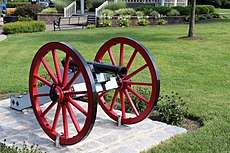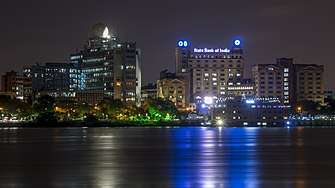Agha Muhammad Reza
Mirza Agha Muhammad Reza Baig, (Bengali: মির্জা আগা মোহাম্মদ রেজা বেগ, Persian: ميرزا آغا محمد رضا بیگ) was a Mughal nobleman from Sylhet of Iranian origin. He overthrew the Kachari Kingdom and revolted against the East India Company with the assistance of the local peasantry.
Mirza Agha Muhammad Reza Baig | |
|---|---|
আগা মোহাম্মদ রেজা | |
| Born | 18th century |
| Died | 19th century Bengal Presidency, British India |
| Nationality | Mughal Empire, British India |
| Occupation | Activist, rebel |
| Known for | Rebelling against the East India Company, claiming to be the Mahdi |
Biography
The honorific title Mirza was added before his name and Baig as a suffix. This was the historical naming convention for the descendants of the Mughal dynasty. The Mughal Empire was defeated by the East India Company in the Battle of Plassey of 1757, and an anti-British sentiment was common among the natives of the Indian subcontinent and especially those related to and being descended from the noble dynasty such as Reza. His parents were Iranians and he was a follower of Shia Islam.[1][2]
Reza was from the Sylhet region. The Collector of Sylhet in the late 18th century, Robert Lindsay, described the Sylhet region as a "hotbed of resistance".[3] Claiming to be a Sufi saint, Reza gained the support of thousands of peasants, fakirs and ryots. It is said he also gained support from Shams ud-Daulah, the Naib Nazim of Dhaka. He made an announcement calling for jihad against the British, who he preached were the reasons of the problems that the peasants were facing.[4]
In 1799, Reza invaded the Kachari Kingdom, which was referred to as his "hijrat", in order to gain a larger following before facing the British in a war. He claimed to be the Mahdi (promised messiah), twelfth imam, promising to free the peasants from oppression. By making a deal with the Nagas and Kukis who were allied with the Kachari Raja, he was able to convince them to join his side. Reza's force proceeded to defeat all the barqandaz (subalterns) sent by the Raja of the Kachari Kingdom, and expelled the King, Raja Krishnachandra Narayan at Khaspur to the nearby hills. After taking over the throne, many Bengali Hindus converted and gave allegiance to him.[5] Here, Reza declared independence of Sylhet from the British.[6][7] He also invited zamindars and other landowners to join him in his mission, promising them more land if they can liberate their country from the British. He then ordered his followers not to pay their taxes to the Company.[2]
Following this, Reza sent 1,200 men to attack the nearby Bondassye thana (now Badarpur, Assam) of the East India Company, administered by a havildar and his eight sepoys.[8] He is also said to have attacked the Badarpur Fort.[9] The Kachari army then arrived with 300 men and two grasshopper cannons but were defeated by Reza's forces. During this time, the British were able to gain a reinforcement of 70 sepoys. The army ended up in a brawl between the Kacharis, and the British sepoys eventually drove both groups back leading to 90 deaths in the Kachari side. Reza escaped but was later arrested on 14 July being sent to a prison in Calcutta.[10][11] He was given lifetime imprisonment for his crimes.[12]
 A replica of the Grasshopper cannon.
A replica of the Grasshopper cannon. Reza spent the rest of his life imprisoned in this city of Calcutta.
Reza spent the rest of his life imprisoned in this city of Calcutta.
See also
- Muharram Rebellion
References
- Banerjee, Anil Chandra (1946). "Troubles in Assam (1795-1824)". The Eastern Frontier Of British India, 1784-1826. Assam: A. Mukherjee. pp. 199–200.
- Sirajul Islam; Aklam Hussain, eds. (1997). History of Bangladesh, 1704-1971. 2. Asiatic Society of Bangladesh. pp. 184–185.
...declared himself 'Imam Mehdi'...
- Syed Zain Al-Mahmood (19 December 2008). "Down the Surma - Origins of the Diaspora". Daily Star. 7 (49). Retrieved 1 May 2019.
- Nitish K. Sengupta (2011). "Sylhet Uprising". Land of Two Rivers: A History of Bengal from the Mahabharata to Mujib. pp. 223–226. ISBN 9780143416784.
- B C Allen (1905). "II. History". Assam District Gazetteers. 2: Sylhet. Calcutta: Government of Assam. pp. 37-38.
- Sirajul Islam; Aklam Hussain, eds. (1997). History of Bangladesh, 1704-1971. 1. Asiatic Society of Bangladesh. pp. 15 & 133-134.
declaration of independence...
- Siddiqi, Rezwana (1995). Cultural Colonization: India-Bangladesh Issues. Bangladesh: Parama Prakashani. p. 18.
- R. C. Majumdar. "Resistance against the British: 3. Religious Frenzy". The Sepoy Mutiny & Revolt of 1857. p. 38.
- Vidyalankar, Shashibhushan. Jibani Kosh. 1. p. 156.
- Barpujari, H K (1990). The Comprehensive History of Assam: Medieval period : political, from thirteen century A.D. to the Treaty of Yandabo, 1826. Assam: Publication Board.
- Sreehatter Itibritta – Purbangsho (A History of Sylhet), Part 2, Volume 1, Chapter 1, Achyut Charan Choudhury; Publisher: Mustafa Selim; Source publication, 2004
- Sirajul Islam. "Peasantry". Banglapedia: National Encyclopedia of Bangladesh. Asiatic Society of Bangladesh.